Related Research Articles

Fortified wine is a wine to which a distilled spirit, usually brandy, has been added. In the course of some centuries, winemakers have developed many different styles of fortified wine, including port, sherry, madeira, Marsala, Commandaria wine, and the aromatised wine vermouth.

Brandy is a liquor produced by distilling wine. Brandy generally contains 35–60% alcohol by volume and is typically consumed as an after-dinner digestif. Some brandies are aged in wooden casks. Others are coloured with caramel colouring to imitate the effect of ageing, and some are produced using a combination of ageing and colouring. Varieties of wine brandy can be found across the winemaking world. Among the most renowned are Cognac and Armagnac from southwestern France.
Pisco is a colorless or yellowish-to-amber colored spirit produced in winemaking regions of Peru and Chile. Made by distilling fermented grape juice into a high-proof spirit, it was developed by 16th-century Spanish settlers as an alternative to orujo, a pomace brandy that was being imported from Spain. It had the advantages of being produced from abundant domestically grown fruit and reducing the volume of alcoholic beverages transported to remote locations.
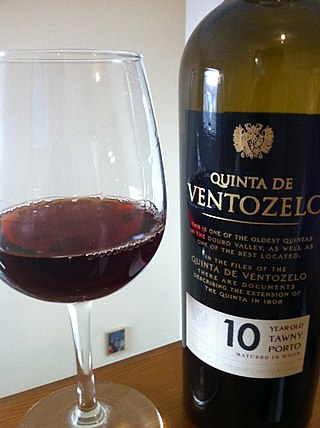
Port wine is a Portuguese fortified wine produced in the Douro Valley of northern Portugal. It is typically a sweet red wine, often served with dessert, although it also comes in dry, semi-dry, and white varieties.
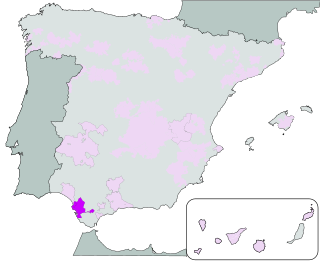
Sherry is a fortified wine made from white grapes that are grown near the city of Jerez de la Frontera in Andalusia, Spain. Sherry is produced in a variety of styles made primarily from the Palomino grape, ranging from light versions similar to white table wines, such as Manzanilla and fino, to darker and heavier versions that have been allowed to oxidise as they age in barrel, such as Amontillado and oloroso. Sweet dessert wines are also made from Pedro Ximénez or Moscatel grapes, and are sometimes blended with Palomino-based sherries.

Pisco is a city located in the Department of Ica of Peru, the capital of the Pisco Province. The city is around 9 metres above sea level. Pisco was founded in 1640, close to the indigenous emplacement of the same name. Pisco originally prospered because of its nearby vineyards and became noted for its grape brandy or pisco which was exported from its port. Pisco has an estimated population of 104,656.

Grappa is an alcoholic beverage: a fragrant, grape-based pomace brandy of Italian origin that contains 35 to 60 percent alcohol by volume.

White wine is a wine that is fermented without skin contact. The colour can be straw-yellow, yellow-green, or yellow-gold. It is produced by the alcoholic fermentation of the non-coloured pulp of grapes, which may have a skin of any colour. White wine has existed for at least 4,000 years.

New World wines are those wines produced outside the traditional winegrowing areas of Europe and the Middle East, in particular from Argentina, Australia, Canada, Chile, Mexico, New Zealand, South Africa and the United States. The phrase connotes a distinction between these "New World" wines and those wines produced in "Old World" countries with a long-established history of wine production, essentially in Europe, most notably: France, Italy, Germany, Spain and Portugal.

A pisco sour is an alcoholic cocktail of Peruvian origin that is typical of Peruvian cuisine. The drink's name comes from pisco, which is its base liquor, and the cocktail term sour, about sour citrus juice and sweetener components. The Peruvian pisco sour uses Peruvian pisco as the base liquor and adds freshly squeezed lemon juice, simple syrup, ice, egg white, and Angostura bitters. The Chilean version is similar, but uses Chilean pisco and Pica lime, and excludes the bitters and egg white. Other variants of the cocktail include those created with fruits like pineapple or plants such as coca leaves.

Aguardente (Portuguese), or aguardiente (Spanish), is a generic term for alcoholic beverages that contain between 29% and 60% alcohol by volume (ABV). It originates in the Iberian Peninsula and in Iberian America.
Peruvian cuisine reflects local practices and ingredients including influences mainly from the indigenous population, including the Inca, and cuisines brought by immigrants from Europe, Asia, and Africa. Without the familiar ingredients from their home countries, immigrants modified their traditional cuisines by using ingredients available in Peru.
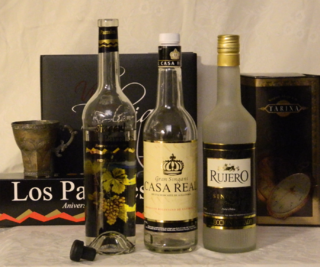
Singani is a Bolivian eau-de-vie or brandy distilled from white Muscat of Alexandria grapes. Only produced in the high valleys of Bolivia, it is the country's national distilled spirit and considered part of its cultural patrimony.
The glossary of wine terms lists the definitions of many general terms used within the wine industry. For terms specific to viticulture, winemaking, grape varieties, and wine tasting, see the topic specific list in the "See also" section below.
This glossary of winemaking terms lists some of terms and definitions involved in making wine, fruit wine, and mead.
Moonshine is a generic term for distilled alcoholic beverages made throughout the globe from indigenous ingredients reflecting the customs, tastes, and raw materials for fermentation available in each region. The term commonly applies to small-scale production, which is often illegal or tightly regulated in many countries, in the same order that is for example making food.
Peruvian wine dates back to the Spanish colonization of the region in the 16th century.
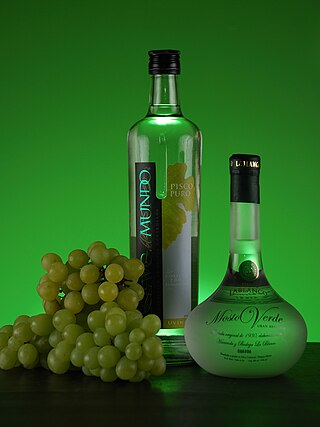
In Peru, pisco is a "designation of origin" that is reserved for the alcoholic beverage belonging to a variety of grape aguardiente produced in Peru since the late 16th century. It is the typical destillate of this country, elaborated from fermented wine of certain grapes, whose value has crossed its borders, as evidenced by the records of shipments made through the port of Pisco to Europe and other parts of the Americas since the 17th century, places such as England, Spain, Portugal, Guatemala, Panama and United States, from the mid-19th century.
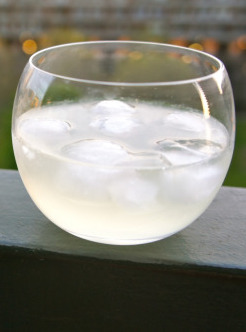
Don Alfredo is a popular cocktail of modern Peruvian cuisine. The drink is prepared by mixing Peruvian mosto verde pisco, elderflower infused liquor such as St-Germain and lime juice in a cocktail glass filled with ice. The glass is then topped off with sparkling mineral water. It is usually served over ice in a lowball glass and garnished with a spring of mint leaf, basil or a lime peel. Other variants include the Don Alfredo Spritz, which adds champagne or cava to the mix, and a plethora of modified versions.
References
- ↑ Jochamowitz, Matias. "Pisco Monteluz", COSAS Hombre (in Spanish), Lima, 10 January 2015.
- ↑ Ministry of Foreign Affairs of Peru. "Pisco y cacao peruano son promocionados en el Reino Unido" (in Spanish), Lima, 16 November 2015.
- ↑ Patrick, Kate. "The Re-birth of Pisco", Luxury Briefing, London, 13 February 2015.